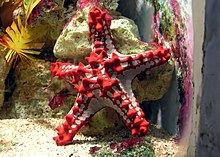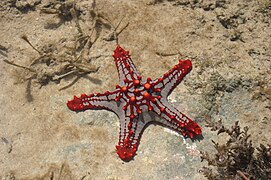Protoreaster lincki
| Protoreaster lincki | |
|---|---|

| |
| Scientific classification | |
| Domain: | Eukaryota |
| Kingdom: | Animalia |
| Phylum: | Echinodermata |
| Class: | Asteroidea |
| Order: | Valvatida |
| Family: | Oreasteridae |
| Genus: | Protoreaster |
| Species: | P. lincki
|
| Binomial name | |
| Protoreaster lincki (Blainville, 1834)
| |
Protoreaster lincki, the red knob sea star, red spine star, African sea star,[1] or the African red knob sea star,[2] is a species of starfish from the Indian Ocean.[3][4]
Description
[edit]
P. lincki grows to a maximum diameter of 12 in (30 cm). It has numerous tubercles located along its five arms. These tubercles are bright red and extend upward from the arms. It has a gray body with red stripes that connect the tubercles. This creates an appearance of a grid made of interconnecting wires.[5]
The skeleton is composed of many calcareous ossicles and spicules. They are located inside the layer of connective tissue. This skeleton supports the large central disk.[6]
-
Off the coast of Kenya.
-
Close to a dead Astropyga radiata
-
Drying
Distribution
[edit]It is distributed in the western Indian Ocean[7][8]
The red-knobbed starfish can only be found in the Indian Ocean, mostly along the African coast and Madagascar, north to India and Sri Lanka. A small population is also present in Coral Bay, Western Australia.[9]
They prefer sandy or muddy seabeds because it is easier for them to search and forage for food. While they are most often seen in shallow tidal pools, they can live in a variety of depths, down to 100 m (330 ft) deep.[10] Red-knobbed starfish are carnivorous animals that eat a number of sea creatures.
Behaviour and diet
[edit]P. lincki is active in both daytime and nighttime.[11] It is a popular aquarium specimen, but is considered incompatible with many other invertebrates, as it will eat soft corals, sponges, tube worms, clams, other starfish, and the like.[12]
It is also a heavily fished species for the curios trade, which contributes to the decline of the species.[9]
References
[edit]- ^ "FishDB - Red Knob Sea Star". www.fishdb.com. Archived from the original on 2012-03-20. Retrieved 2016-04-10.
- ^ "Ask a Vet Online 24/7 - PetCoach".
- ^ "View Protoreaster lincki". www.saltcorner.com. Retrieved 2016-04-10.
- ^ Zicha, Ondrej. "BioLib: Biological library". www.biolib.cz. Retrieved 2016-04-10.
- ^ "Ask a Vet Online 24/7 - PetCoach".
- ^ Byern, Janek von; Grunwald, Ingo (2011-01-27). Biological Adhesive Systems: From Nature to Technical and Medical Application. Springer Science & Business Media. ISBN 9783709102862.
- ^ Indiviglio, Frank (2006-10-12). The Everything Aquarium Book: All You Need to Build the Aquarium of Your Dreams. Everything Books. ISBN 1440523894.
- ^ "FreshMarine.com - African Red-Knob Sea Star - Protoreaster lincki - Buy Cheap Red Knob at Wholesale". www.freshmarine.com. Retrieved 2016-04-10.
- ^ a b Ducarme, Frédéric (2022). "How to assess the absence of a species? A revision of the geographical range of the horned sea star, Protoreaster nodosus (Echinodermata; Asteroidea)". Frontiers of Biogeography. 14 (3). doi:10.21425/F5FBG56187.
- ^ "Ask a Vet Online 24/7 - PetCoach".
- ^ "FishDB - Red Knob Sea Star". www.fishdb.com. Archived from the original on 2012-03-20. Retrieved 2016-04-10.
- ^ "Red Knob Sea Star – Protoreaster linckii | Aquariums Life". www.aquariumslife.com. Archived from the original on 2010-12-02.
{{cite web}}: CS1 maint: unfit URL (link)
Bibliography
[edit]- Ducarme, Frédéric (2022). "How to assess the absence of a species? A revision of the geographical range of the horned sea star, Protoreaster nodosus (Echinodermata; Asteroidea)". Frontiers of Biogeography. 14 (3). doi:10.21425/F5FBG56187.
External links
[edit]




